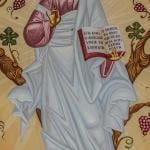BRIDE OF SUBTLESTEIN: The generally excellent Bright Lights Film Journal ran an article speculating about homosexual subtexts (you know, subtexts that like other subtexts) in James Whale’s “Bride of Frankenstein.” Given that the article was dedicated to exploring nuances, you’d think its own stance would be nuanced; but you’d be wrong. The article paints Whale as a Stonewall cheerleader avant la lettre. In the process, the author ignores every other possible reading of the movies–which makes the movies less interesting, not more. (Warning: spoiler ahead.)
There’s a lot of good stuff in the article, such as the observation that “a genre effort like ‘Bride,’ full of fantasy and monster-outsiders, was clearly the perfect medium for indulging the most radical aspects of a gay sensibility…” And I’d never deny that the subtexts the article points out are there, and they add depth and intrigue to the movie. “Bride” deals with two men who create a new life–that’s a subtext that’s barely sub. Henry Frankenstein’s desire to work with Dr. Pretorius to create a monster-bride even gets in the way of his impending marriage. The BLFJ article gives a quick summary of lines that show Pretorius as a seductive homosexual figure.
Henry’s fiancee Elizabeth describes the tension in their relationship thus: “The figure of death seems to be reaching for you, as if it would take you away from me.” Bright Lights comments, “‘[D]eath’ here can be read as a heterosexist vision of homosexuality, a kind of barrenness, the inability–or worse, indifference–to producing children. Henry’s crime, and his lure, is therefore: homosexuality.”
Well, maybe. And maybe his lure is, in fact, death. It’s not as if thanatos is a drive unknown to film. And “Bride” features several death-haunted scenes, as when the monster sits among skeletons and muses, “Love dead–hate living!” Maybe Whale is presenting a dichotomy between childbearing and scientific/artistic creation–and maybe he’s ambivalent about which one truly represents life, and which death. Henry’s ambivalence toward the original monster–the creator is “alternately excited and repulsed by what he has produced,” as BLFJ puts it–would fit better with this interpretation than with the Journal‘s. The menace in Dr. Pretorius’s behavior also fits with a more unsettled, less rah-rah-Gay-Liberation interpretation, since Pretorius is the homo alternative to fiancee Elizabeth.
“Bride” presents another alternative to marriage: the relationship between the monster and the blind hermit. BLFJ is right to note the tenderness, domestic humor, and implied satire of the nuclear family in the hermit scenes. But this alternative is only offered to the monster, the creation, the less-aware; the creator, Henry, has only Pretorius.
BLFJ‘s interpretation focuses on one thread running through the movie. The usual Hollywood back-to-normal ending may have been tacked on solely to please the studio and Middle America. But the movie offers wide latitude for other, more disturbing, less self-affirming readings. “Gods and Monsters” had a more nuanced and perceptive take on Whale, one that was less dogmatically tied to one interpretation of his work.










